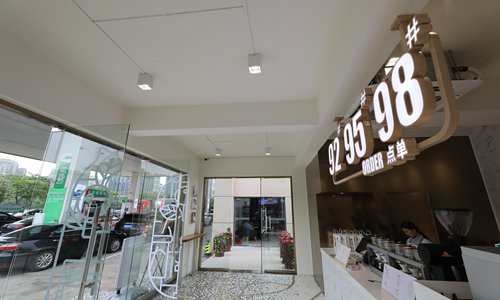Gasoline demand picks up, but Chinese oil majors still need to tighten belts
By Wang Sheng Source:Global Times Published: 2020/6/1 17:51:43

A filling station operated by China Petroleum & Chemical Corp (Sinopec) set up a cafe called Yijie inside the station on Wednesday in Suzhou, East China's Jiangsu Province. The coffee drinks are named after grades of gasoline - 92-octane, 95-octane and 98-octane, a marketing tactic that attracted many drivers. It's Sinopec's first such cafe, and it is been reported that a branch of the cafe will soon land in Hangzhou, capital of East China's Zhejiang Province. Photo: VCG
More and more cars are running on the roads as coronavirus lockdown measures significantly ease in China. The country is now well on its road to regaining economic vitality.
In a Sinopec-owned filling station in Chaoyang district, Beijing Monday morning, several cars drove in for a refill. Sinopec has boosted its sales of refined products but has yet to recover fully to the level before the COVID-19 outbreak, an employee close to the Sinopec Fuel Oil Sale Corp, a fully owned subsidiary of the China Petroleum & Chemical Corp (Sinopec), told the Global Times Monday.
Chinese oil demand will recover to 13 million barrels per day (bpd) in the second quarter of 2020, a 16.3 percent increase compared to the first quarter but down 2.5 percent from a year earlier, according to energy consultancy Wood Mackenzie.
It is notable that the speed of recovery varies across oil products. China's demand for gasoline and diesel is expected to increase in the third quarter. Wood Mackenzie estimates gasoline demand will reach 3.4 million bpd in the second quarter, just a 0.8 percent drop year-on-year. By the third quarter of this year, China's gasoline demand is expected to surpass the same period last year by 3 percent, rising to 3.5 million bpd.
Chinese jet fuel demand, however, will continue to fall for the rest of the year. Wood Mackenzie expects an even larger year-on-year demand decline of 51 per cent to merely 0.4 million bpd in the second quarter as airlines continue to struggle in the aftermath of the COVID-19 onslaught.
Overall, Chinese oil demand is expected to rise a modest 2.3 percent year-on-year to 13.6 million bpd for the second half of 2020, said Wood Mackenzie.
While oil demand is recovering, domestic oil companies still need to tighten their belts as low oil prices are deteriorating the oil sector upstream, analysts told the Global Times.
In response to low oil prices, national oil companies cut their capital expenditures in 2020. The China National Petroleum Corp plans to cut its capital spending by around 30 percent to 200 billion yuan ($28.33 billion), according to market information provider S&P Global Platts.
Brent crude futures, the global benchmark, stood at $37.80 per barrel on Monday, while West Intermediate futures were at $35.50 per barrel, entering negative territory for the first time in April.
Dong Xiucheng, professor at the University of International Business and Economics, expects oil prices will range from $30 to $50 per barrel in the coming months, lower than the $50 per barrel production cost for many oilfields in China. The OPEC and its allies have cut production to boost prices.
Global Times
Posted in: INDUSTRIES,MARKETS